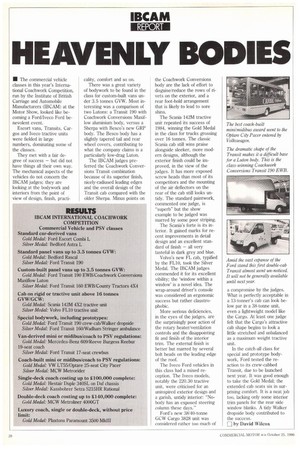HEAV EN LY BODIES
Page 30

If you've noticed an error in this article please click here to report it so we can fix it.
• The commercial vehicle classes in this year's International Coachwork Competition, run by the Institute of British Carriage and Automobile Manufacturers (IBCAM) at the Motor Show, looked like becoming a Ford/Iveco Ford benevolent event.
Escort vans, Transits, Cargos and Iveco tractive units were fielded in large numbers, dominating some of the classes.
They met with a fair degree of success — but did not have things all their own way. The mechanical aspects of the vehicles do not concern the IBCAM judges; they are looking at the bodywork and interiors from the point of view of design, finish, practi
cality, comfort and so on.
There was a great variety of bodywork to be found in the class for custom-built vans under 3.5 tonnes GVW. Most interesting was a comparison of two Lutons: a Transit 190 with Coachwork Conversions Maxiflow aluminium body, versus a Sherpa with Besco's new GRP body. The Besco body has a slightly tapered tail and rear wheel covers, contributing to what the company claims is a particularly low-drag Luton.
The IBCAM judges preferred the Coachwork Conversions Transit combination because of its superior finish, nicely-radiused leading edges and the overall design of the Transit cab compared with the older Sherpa. Minus points on the Coachwork Conversions body are the lack of effort to disguise/reduce the rows of rivets on the exterior, and a rear foot-hold arrangement that is likely to lead to sore shins.
The Scania 142M tractive unit repeated its success of 1984, winning the Gold Medal in the class for trucks grossing over 16 tonnes. The classic Scania cab still wins praise alongside sleeker, more modern designs, although the exterior finish could be improved, in the view of the judges. It has more exposed screw heads than most of its competitors and the mounting of the air deflectors on the rear of the cab still looks untidy. The standard paintwork, commented one judge, is superb" but the show example to be judged was marred by some poor striping.
The Scania's forte is its interior. It gained marks for recent improvements in detail design and an excellent standard of finish — all very tasteful in dark grey and blue.
Volvo's new FL cab, typified by the FL10, took the Silver Medal. The IBCAM judges commended it for its excellent vibility; the 'window within a window' is a novel idea. The wrap-around driver's console was considered an ergonomic success but rather claustrophobic.
More serious deficiencies, in the eyes of the judges, are the surprisingly poor action of the rotary heater/ventilation controls and the disappointing lit and finish of the interior trim. The external finish is better but marred by several bolt heads on the leading edge of the roof.
The Iveco Ford vehicles in this class had a mixed reception. The Iveco models, notably the 220.30 tractive unit, were criticised for an uninspired exterior design and a garish, untidy interior: "Nobody has an exposed steering column these days."
Ford's new 38/40-tonne GCW Cargo 3828 unit was considered rather too much of a compromise by the judges. What is perfectly acceptable in a 13-tonner's cab can look below par in a 38-tonne unit, even a lightweight model like the Cargo. At least one judge felt that the Cargo's attractive cab shape begins to look a little stretched and unbalanced as a maximum weight tractive unit.
In the catch-all class for special and prototype bodywork, Ford tested the reaction to its crew-cabbed Transit, due to be launched next year. It was good enough to take the Gold Medal; the extended cab seats six in surprising comfort It is a neat job too, lacking only some interior trim panels for the rear side window blanks. A tidy Walker dropside body contributed to the success.
by David Wilcox




































































































































